Qantas Airways: Strategic Implementation Plan and Performance Analysis
VerifiedAdded on 2022/08/12
|21
|4791
|11
Report
AI Summary
This report provides a comprehensive analysis of Qantas Airways' strategic implementation plan, building upon a previous assessment of the airline's external and internal environments. It begins with an executive summary highlighting the company's performance and legal considerations. The report delves into an internal analysis using the resource-based view model, assessing the value, rarity, imitability, and non-substitutability of Qantas' resources, including financial assets, patents, distribution networks, and employee training programs. A performance gap analysis identifies areas where Qantas can improve, such as employee retention and financial returns. The report then presents a SWOT analysis, evaluating the airline's strengths, weaknesses, opportunities, and threats. Based on this analysis, three strategic options are proposed: utilizing AI and ML programs, managing fuel price fluctuations, and avoiding price wars. An implementation plan is outlined, including steps, leadership applications, time durations, and progress measurement. The report concludes with a change management process and references.
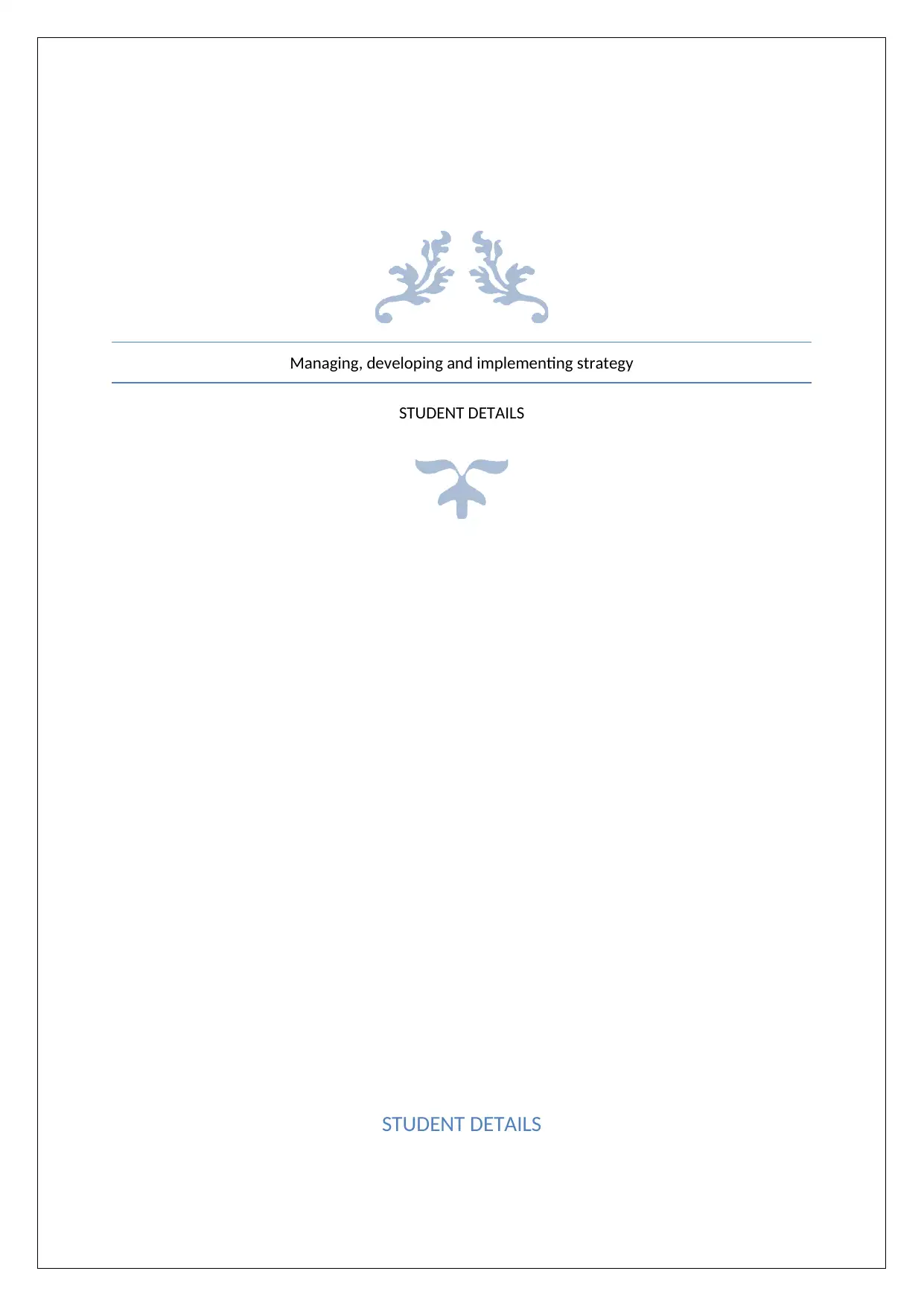
Managing, developing and implementing strategy
STUDENT DETAILS
STUDENT DETAILS
STUDENT DETAILS
STUDENT DETAILS
Paraphrase This Document
Need a fresh take? Get an instant paraphrase of this document with our AI Paraphraser
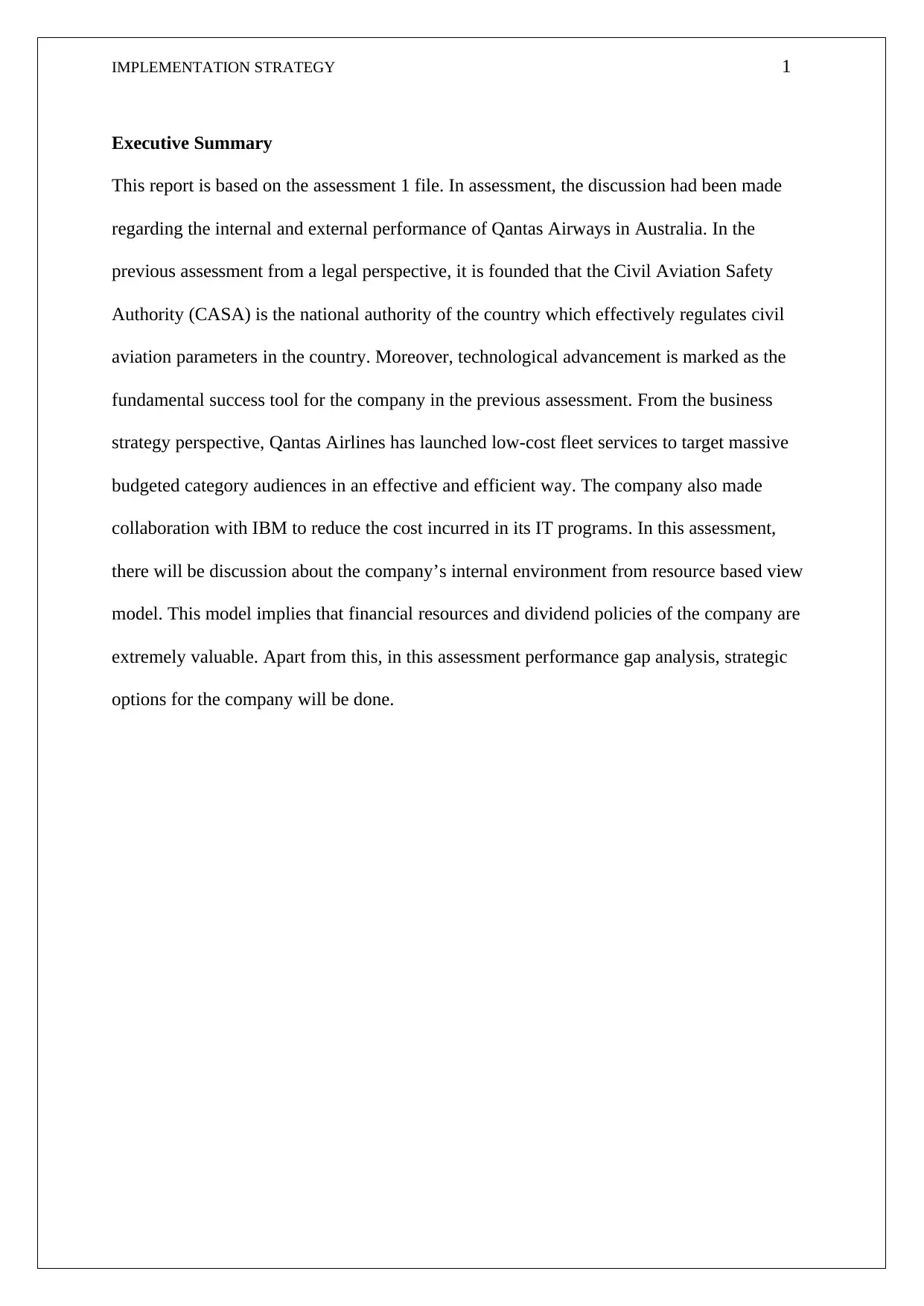
IMPLEMENTATION STRATEGY 1
Executive Summary
This report is based on the assessment 1 file. In assessment, the discussion had been made
regarding the internal and external performance of Qantas Airways in Australia. In the
previous assessment from a legal perspective, it is founded that the Civil Aviation Safety
Authority (CASA) is the national authority of the country which effectively regulates civil
aviation parameters in the country. Moreover, technological advancement is marked as the
fundamental success tool for the company in the previous assessment. From the business
strategy perspective, Qantas Airlines has launched low-cost fleet services to target massive
budgeted category audiences in an effective and efficient way. The company also made
collaboration with IBM to reduce the cost incurred in its IT programs. In this assessment,
there will be discussion about the company’s internal environment from resource based view
model. This model implies that financial resources and dividend policies of the company are
extremely valuable. Apart from this, in this assessment performance gap analysis, strategic
options for the company will be done.
Executive Summary
This report is based on the assessment 1 file. In assessment, the discussion had been made
regarding the internal and external performance of Qantas Airways in Australia. In the
previous assessment from a legal perspective, it is founded that the Civil Aviation Safety
Authority (CASA) is the national authority of the country which effectively regulates civil
aviation parameters in the country. Moreover, technological advancement is marked as the
fundamental success tool for the company in the previous assessment. From the business
strategy perspective, Qantas Airlines has launched low-cost fleet services to target massive
budgeted category audiences in an effective and efficient way. The company also made
collaboration with IBM to reduce the cost incurred in its IT programs. In this assessment,
there will be discussion about the company’s internal environment from resource based view
model. This model implies that financial resources and dividend policies of the company are
extremely valuable. Apart from this, in this assessment performance gap analysis, strategic
options for the company will be done.
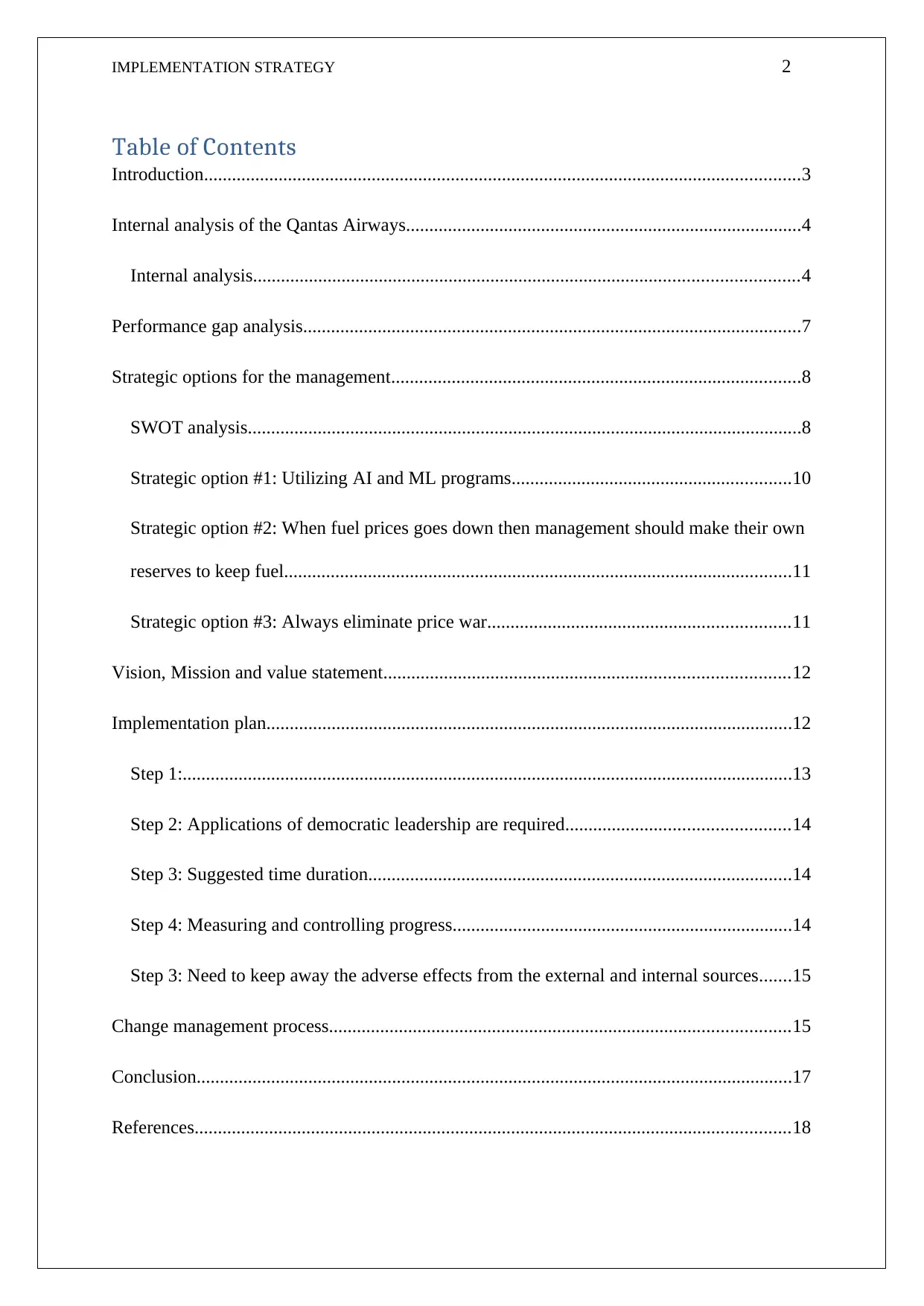
IMPLEMENTATION STRATEGY 2
Table of Contents
Introduction................................................................................................................................3
Internal analysis of the Qantas Airways.....................................................................................4
Internal analysis.....................................................................................................................4
Performance gap analysis...........................................................................................................7
Strategic options for the management........................................................................................8
SWOT analysis.......................................................................................................................8
Strategic option #1: Utilizing AI and ML programs............................................................10
Strategic option #2: When fuel prices goes down then management should make their own
reserves to keep fuel.............................................................................................................11
Strategic option #3: Always eliminate price war.................................................................11
Vision, Mission and value statement.......................................................................................12
Implementation plan.................................................................................................................12
Step 1:...................................................................................................................................13
Step 2: Applications of democratic leadership are required................................................14
Step 3: Suggested time duration...........................................................................................14
Step 4: Measuring and controlling progress.........................................................................14
Step 3: Need to keep away the adverse effects from the external and internal sources.......15
Change management process...................................................................................................15
Conclusion................................................................................................................................17
References................................................................................................................................18
Table of Contents
Introduction................................................................................................................................3
Internal analysis of the Qantas Airways.....................................................................................4
Internal analysis.....................................................................................................................4
Performance gap analysis...........................................................................................................7
Strategic options for the management........................................................................................8
SWOT analysis.......................................................................................................................8
Strategic option #1: Utilizing AI and ML programs............................................................10
Strategic option #2: When fuel prices goes down then management should make their own
reserves to keep fuel.............................................................................................................11
Strategic option #3: Always eliminate price war.................................................................11
Vision, Mission and value statement.......................................................................................12
Implementation plan.................................................................................................................12
Step 1:...................................................................................................................................13
Step 2: Applications of democratic leadership are required................................................14
Step 3: Suggested time duration...........................................................................................14
Step 4: Measuring and controlling progress.........................................................................14
Step 3: Need to keep away the adverse effects from the external and internal sources.......15
Change management process...................................................................................................15
Conclusion................................................................................................................................17
References................................................................................................................................18
⊘ This is a preview!⊘
Do you want full access?
Subscribe today to unlock all pages.

Trusted by 1+ million students worldwide
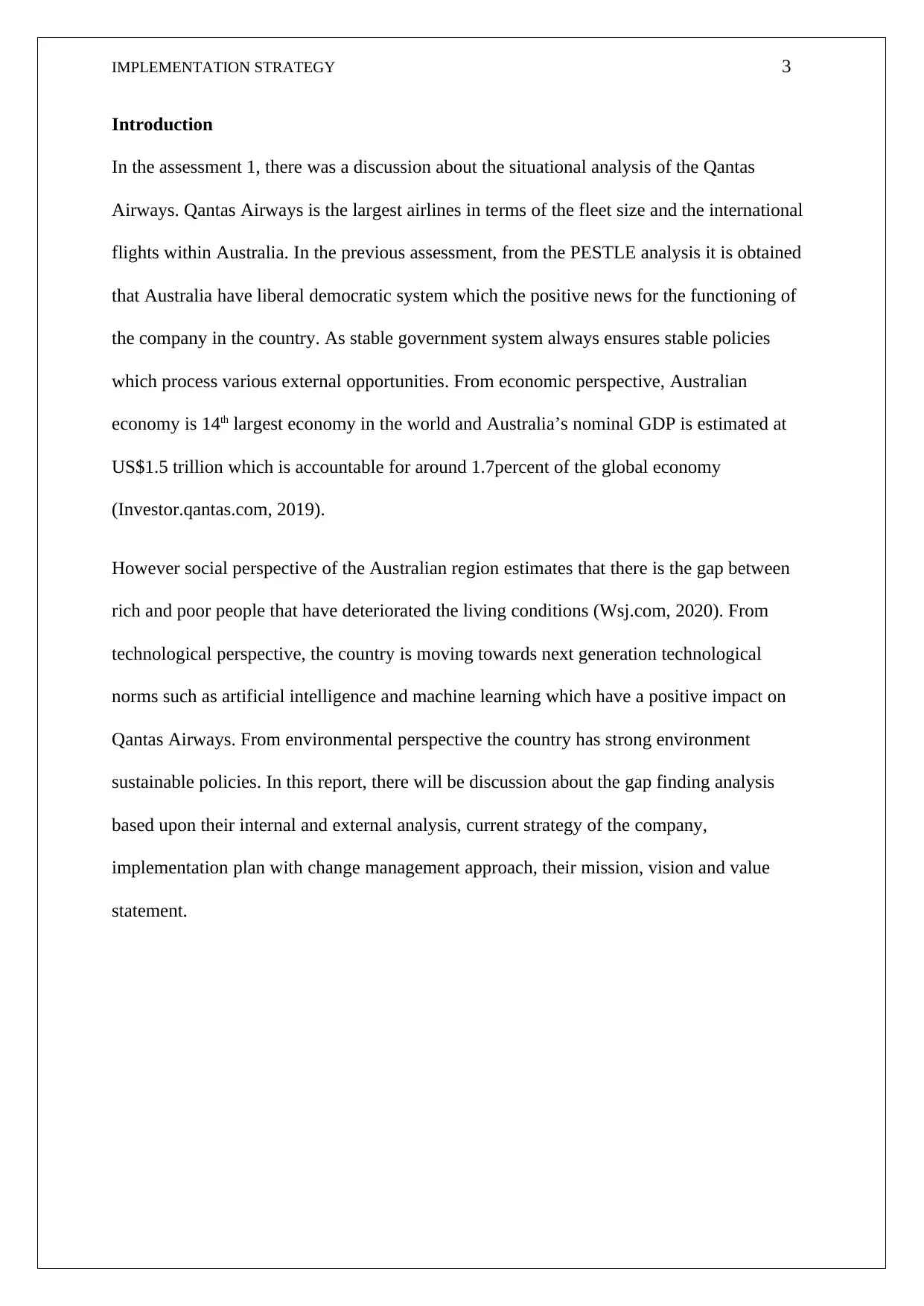
IMPLEMENTATION STRATEGY 3
Introduction
In the assessment 1, there was a discussion about the situational analysis of the Qantas
Airways. Qantas Airways is the largest airlines in terms of the fleet size and the international
flights within Australia. In the previous assessment, from the PESTLE analysis it is obtained
that Australia have liberal democratic system which the positive news for the functioning of
the company in the country. As stable government system always ensures stable policies
which process various external opportunities. From economic perspective, Australian
economy is 14th largest economy in the world and Australia’s nominal GDP is estimated at
US$1.5 trillion which is accountable for around 1.7percent of the global economy
(Investor.qantas.com, 2019).
However social perspective of the Australian region estimates that there is the gap between
rich and poor people that have deteriorated the living conditions (Wsj.com, 2020). From
technological perspective, the country is moving towards next generation technological
norms such as artificial intelligence and machine learning which have a positive impact on
Qantas Airways. From environmental perspective the country has strong environment
sustainable policies. In this report, there will be discussion about the gap finding analysis
based upon their internal and external analysis, current strategy of the company,
implementation plan with change management approach, their mission, vision and value
statement.
Introduction
In the assessment 1, there was a discussion about the situational analysis of the Qantas
Airways. Qantas Airways is the largest airlines in terms of the fleet size and the international
flights within Australia. In the previous assessment, from the PESTLE analysis it is obtained
that Australia have liberal democratic system which the positive news for the functioning of
the company in the country. As stable government system always ensures stable policies
which process various external opportunities. From economic perspective, Australian
economy is 14th largest economy in the world and Australia’s nominal GDP is estimated at
US$1.5 trillion which is accountable for around 1.7percent of the global economy
(Investor.qantas.com, 2019).
However social perspective of the Australian region estimates that there is the gap between
rich and poor people that have deteriorated the living conditions (Wsj.com, 2020). From
technological perspective, the country is moving towards next generation technological
norms such as artificial intelligence and machine learning which have a positive impact on
Qantas Airways. From environmental perspective the country has strong environment
sustainable policies. In this report, there will be discussion about the gap finding analysis
based upon their internal and external analysis, current strategy of the company,
implementation plan with change management approach, their mission, vision and value
statement.
Paraphrase This Document
Need a fresh take? Get an instant paraphrase of this document with our AI Paraphraser
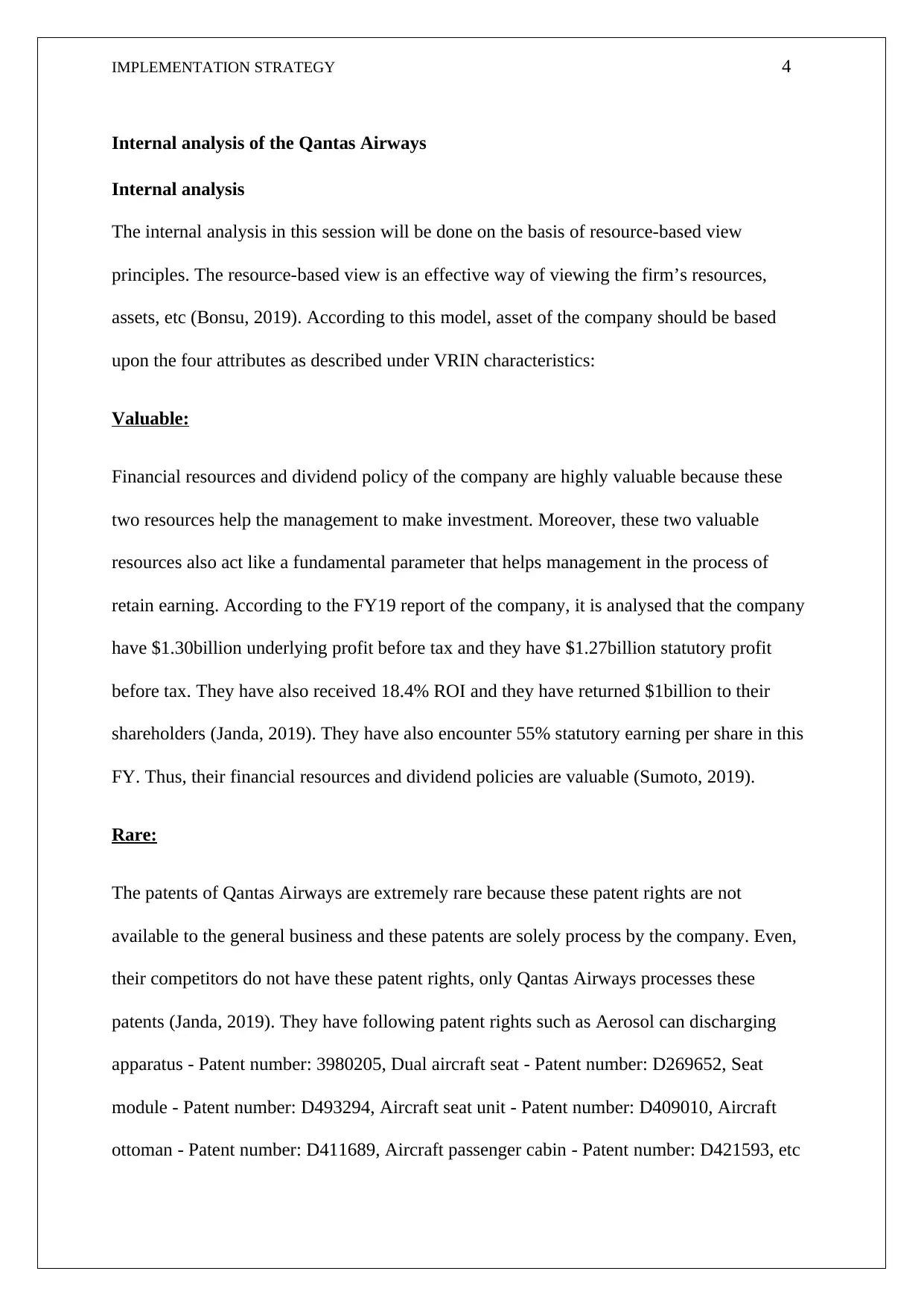
IMPLEMENTATION STRATEGY 4
Internal analysis of the Qantas Airways
Internal analysis
The internal analysis in this session will be done on the basis of resource-based view
principles. The resource-based view is an effective way of viewing the firm’s resources,
assets, etc (Bonsu, 2019). According to this model, asset of the company should be based
upon the four attributes as described under VRIN characteristics:
Valuable:
Financial resources and dividend policy of the company are highly valuable because these
two resources help the management to make investment. Moreover, these two valuable
resources also act like a fundamental parameter that helps management in the process of
retain earning. According to the FY19 report of the company, it is analysed that the company
have $1.30billion underlying profit before tax and they have $1.27billion statutory profit
before tax. They have also received 18.4% ROI and they have returned $1billion to their
shareholders (Janda, 2019). They have also encounter 55% statutory earning per share in this
FY. Thus, their financial resources and dividend policies are valuable (Sumoto, 2019).
Rare:
The patents of Qantas Airways are extremely rare because these patent rights are not
available to the general business and these patents are solely process by the company. Even,
their competitors do not have these patent rights, only Qantas Airways processes these
patents (Janda, 2019). They have following patent rights such as Aerosol can discharging
apparatus - Patent number: 3980205, Dual aircraft seat - Patent number: D269652, Seat
module - Patent number: D493294, Aircraft seat unit - Patent number: D409010, Aircraft
ottoman - Patent number: D411689, Aircraft passenger cabin - Patent number: D421593, etc
Internal analysis of the Qantas Airways
Internal analysis
The internal analysis in this session will be done on the basis of resource-based view
principles. The resource-based view is an effective way of viewing the firm’s resources,
assets, etc (Bonsu, 2019). According to this model, asset of the company should be based
upon the four attributes as described under VRIN characteristics:
Valuable:
Financial resources and dividend policy of the company are highly valuable because these
two resources help the management to make investment. Moreover, these two valuable
resources also act like a fundamental parameter that helps management in the process of
retain earning. According to the FY19 report of the company, it is analysed that the company
have $1.30billion underlying profit before tax and they have $1.27billion statutory profit
before tax. They have also received 18.4% ROI and they have returned $1billion to their
shareholders (Janda, 2019). They have also encounter 55% statutory earning per share in this
FY. Thus, their financial resources and dividend policies are valuable (Sumoto, 2019).
Rare:
The patents of Qantas Airways are extremely rare because these patent rights are not
available to the general business and these patents are solely process by the company. Even,
their competitors do not have these patent rights, only Qantas Airways processes these
patents (Janda, 2019). They have following patent rights such as Aerosol can discharging
apparatus - Patent number: 3980205, Dual aircraft seat - Patent number: D269652, Seat
module - Patent number: D493294, Aircraft seat unit - Patent number: D409010, Aircraft
ottoman - Patent number: D411689, Aircraft passenger cabin - Patent number: D421593, etc
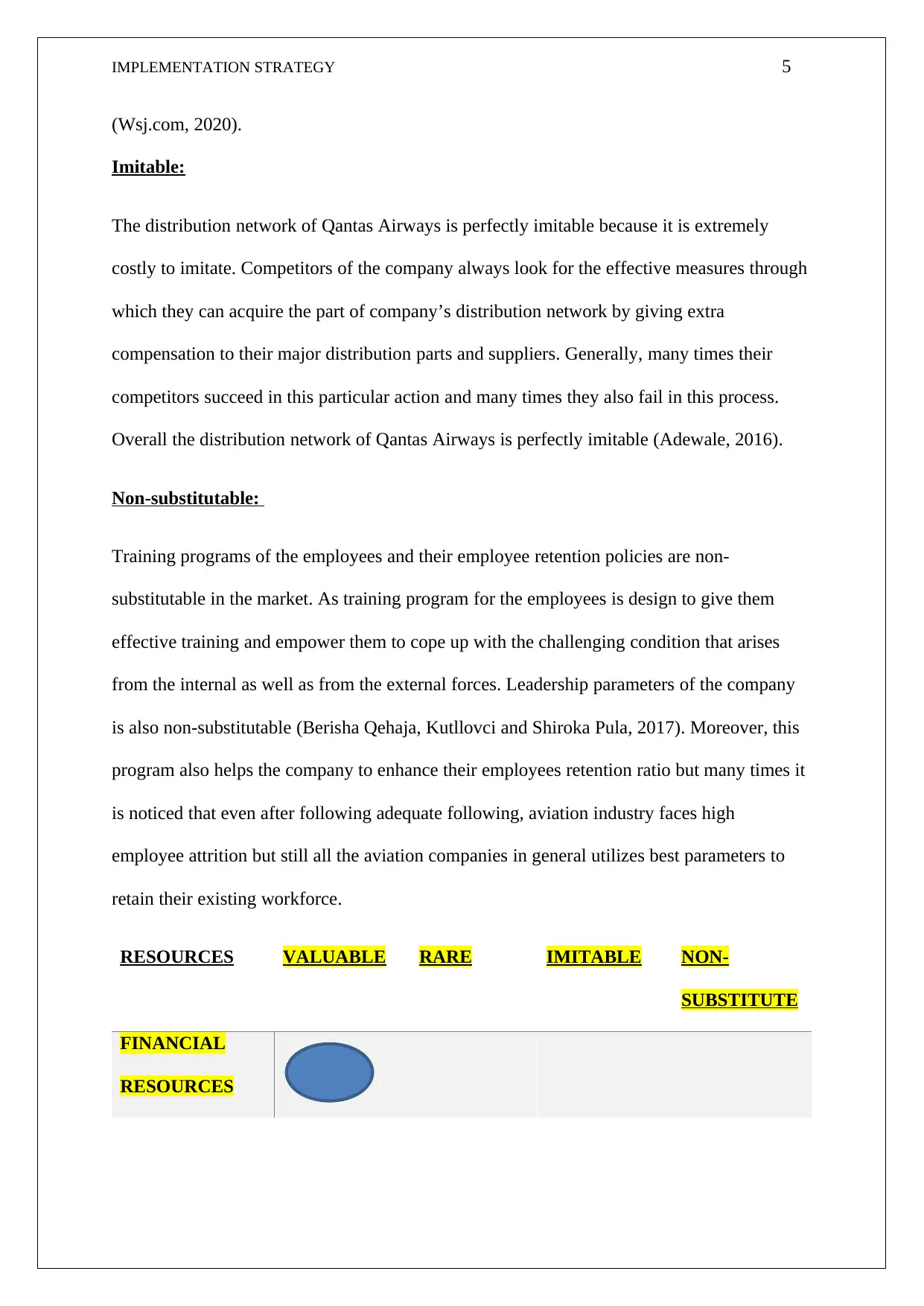
IMPLEMENTATION STRATEGY 5
(Wsj.com, 2020).
Imitable:
The distribution network of Qantas Airways is perfectly imitable because it is extremely
costly to imitate. Competitors of the company always look for the effective measures through
which they can acquire the part of company’s distribution network by giving extra
compensation to their major distribution parts and suppliers. Generally, many times their
competitors succeed in this particular action and many times they also fail in this process.
Overall the distribution network of Qantas Airways is perfectly imitable (Adewale, 2016).
Non-substitutable:
Training programs of the employees and their employee retention policies are non-
substitutable in the market. As training program for the employees is design to give them
effective training and empower them to cope up with the challenging condition that arises
from the internal as well as from the external forces. Leadership parameters of the company
is also non-substitutable (Berisha Qehaja, Kutllovci and Shiroka Pula, 2017). Moreover, this
program also helps the company to enhance their employees retention ratio but many times it
is noticed that even after following adequate following, aviation industry faces high
employee attrition but still all the aviation companies in general utilizes best parameters to
retain their existing workforce.
RESOURCES VALUABLE RARE IMITABLE NON-
SUBSTITUTE
FINANCIAL
RESOURCES
(Wsj.com, 2020).
Imitable:
The distribution network of Qantas Airways is perfectly imitable because it is extremely
costly to imitate. Competitors of the company always look for the effective measures through
which they can acquire the part of company’s distribution network by giving extra
compensation to their major distribution parts and suppliers. Generally, many times their
competitors succeed in this particular action and many times they also fail in this process.
Overall the distribution network of Qantas Airways is perfectly imitable (Adewale, 2016).
Non-substitutable:
Training programs of the employees and their employee retention policies are non-
substitutable in the market. As training program for the employees is design to give them
effective training and empower them to cope up with the challenging condition that arises
from the internal as well as from the external forces. Leadership parameters of the company
is also non-substitutable (Berisha Qehaja, Kutllovci and Shiroka Pula, 2017). Moreover, this
program also helps the company to enhance their employees retention ratio but many times it
is noticed that even after following adequate following, aviation industry faces high
employee attrition but still all the aviation companies in general utilizes best parameters to
retain their existing workforce.
RESOURCES VALUABLE RARE IMITABLE NON-
SUBSTITUTE
FINANCIAL
RESOURCES
⊘ This is a preview!⊘
Do you want full access?
Subscribe today to unlock all pages.

Trusted by 1+ million students worldwide
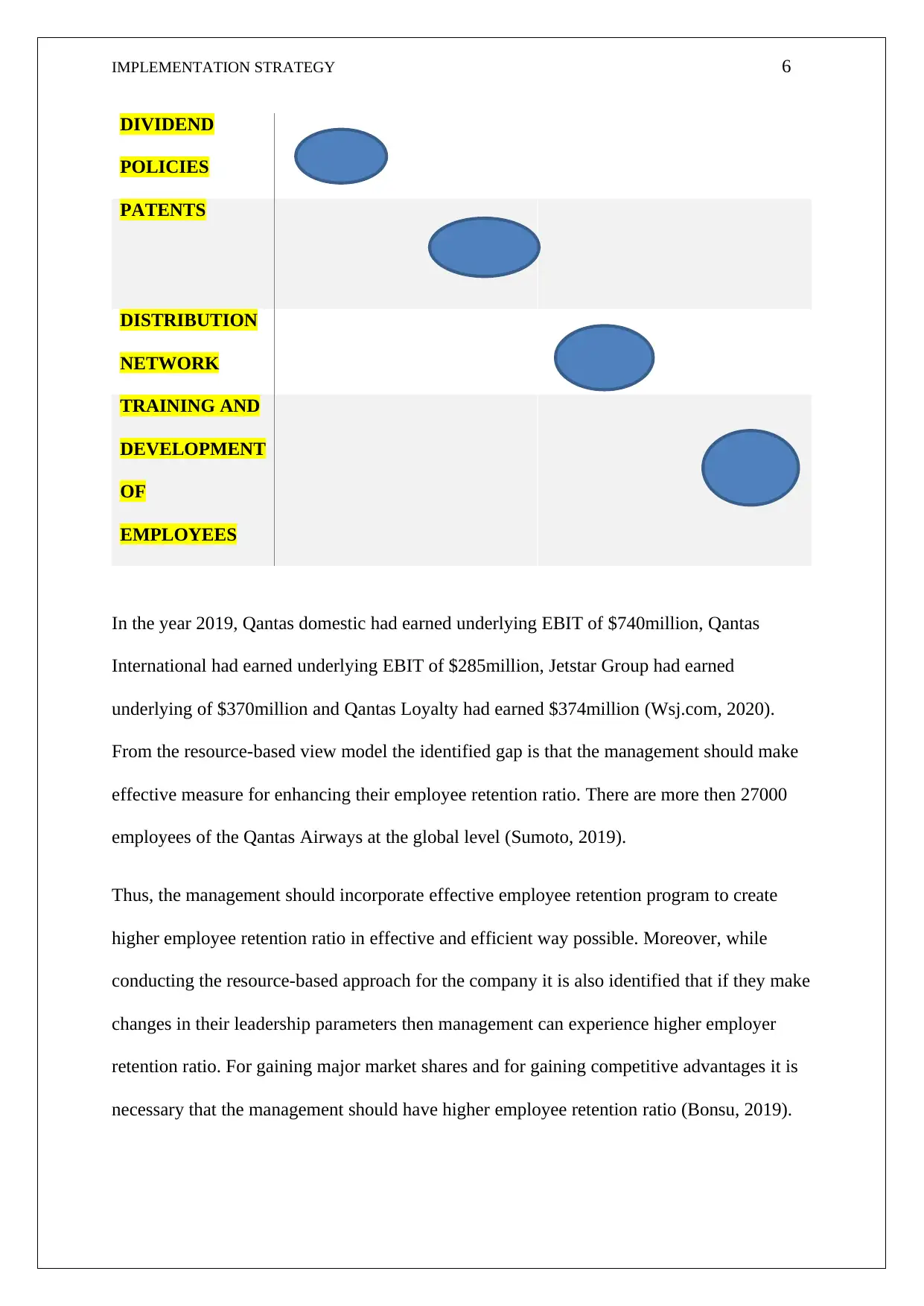
IMPLEMENTATION STRATEGY 6
DIVIDEND
POLICIES
PATENTS
DISTRIBUTION
NETWORK
TRAINING AND
DEVELOPMENT
OF
EMPLOYEES
In the year 2019, Qantas domestic had earned underlying EBIT of $740million, Qantas
International had earned underlying EBIT of $285million, Jetstar Group had earned
underlying of $370million and Qantas Loyalty had earned $374million (Wsj.com, 2020).
From the resource-based view model the identified gap is that the management should make
effective measure for enhancing their employee retention ratio. There are more then 27000
employees of the Qantas Airways at the global level (Sumoto, 2019).
Thus, the management should incorporate effective employee retention program to create
higher employee retention ratio in effective and efficient way possible. Moreover, while
conducting the resource-based approach for the company it is also identified that if they make
changes in their leadership parameters then management can experience higher employer
retention ratio. For gaining major market shares and for gaining competitive advantages it is
necessary that the management should have higher employee retention ratio (Bonsu, 2019).
DIVIDEND
POLICIES
PATENTS
DISTRIBUTION
NETWORK
TRAINING AND
DEVELOPMENT
OF
EMPLOYEES
In the year 2019, Qantas domestic had earned underlying EBIT of $740million, Qantas
International had earned underlying EBIT of $285million, Jetstar Group had earned
underlying of $370million and Qantas Loyalty had earned $374million (Wsj.com, 2020).
From the resource-based view model the identified gap is that the management should make
effective measure for enhancing their employee retention ratio. There are more then 27000
employees of the Qantas Airways at the global level (Sumoto, 2019).
Thus, the management should incorporate effective employee retention program to create
higher employee retention ratio in effective and efficient way possible. Moreover, while
conducting the resource-based approach for the company it is also identified that if they make
changes in their leadership parameters then management can experience higher employer
retention ratio. For gaining major market shares and for gaining competitive advantages it is
necessary that the management should have higher employee retention ratio (Bonsu, 2019).
Paraphrase This Document
Need a fresh take? Get an instant paraphrase of this document with our AI Paraphraser
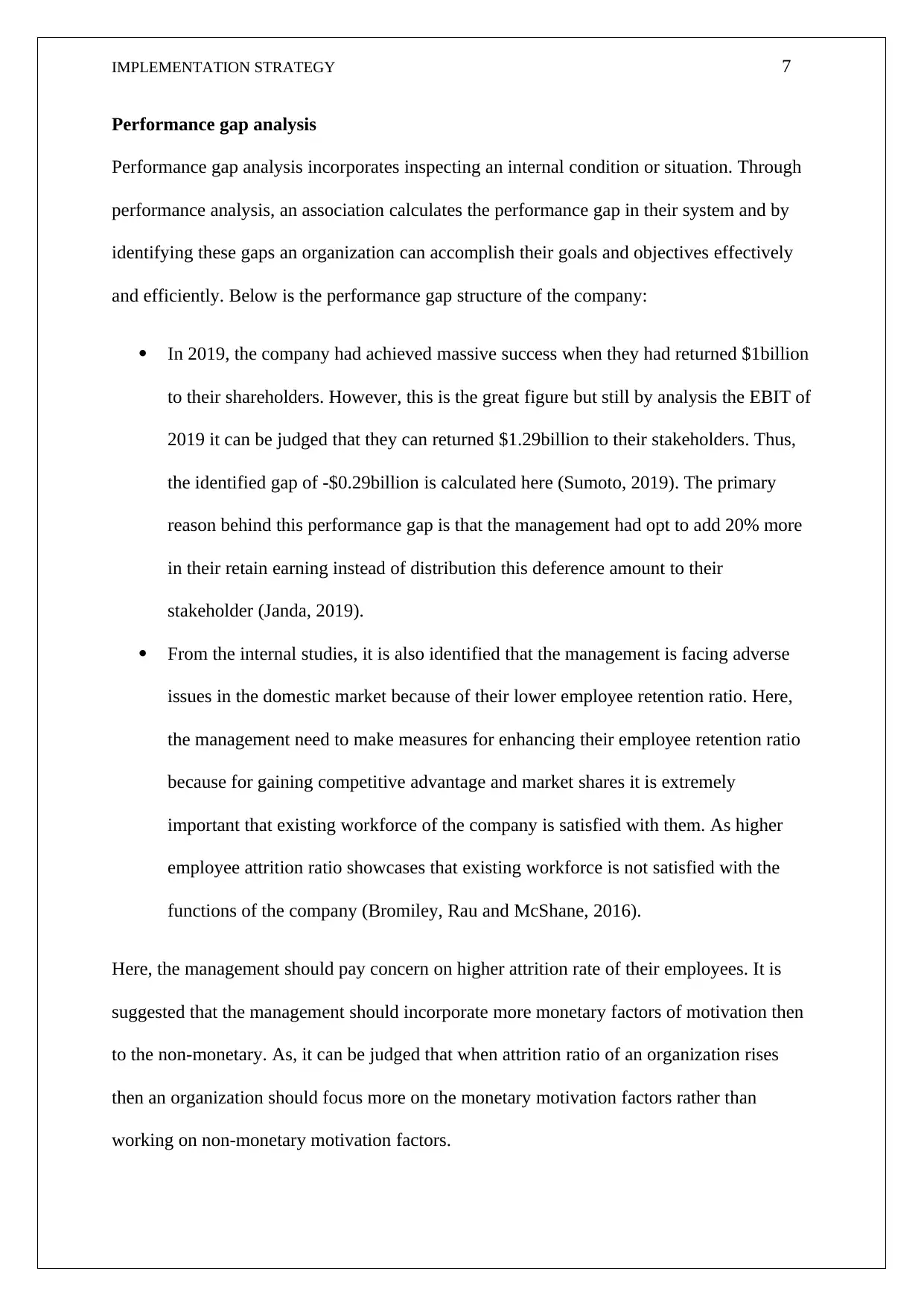
IMPLEMENTATION STRATEGY 7
Performance gap analysis
Performance gap analysis incorporates inspecting an internal condition or situation. Through
performance analysis, an association calculates the performance gap in their system and by
identifying these gaps an organization can accomplish their goals and objectives effectively
and efficiently. Below is the performance gap structure of the company:
In 2019, the company had achieved massive success when they had returned $1billion
to their shareholders. However, this is the great figure but still by analysis the EBIT of
2019 it can be judged that they can returned $1.29billion to their stakeholders. Thus,
the identified gap of -$0.29billion is calculated here (Sumoto, 2019). The primary
reason behind this performance gap is that the management had opt to add 20% more
in their retain earning instead of distribution this deference amount to their
stakeholder (Janda, 2019).
From the internal studies, it is also identified that the management is facing adverse
issues in the domestic market because of their lower employee retention ratio. Here,
the management need to make measures for enhancing their employee retention ratio
because for gaining competitive advantage and market shares it is extremely
important that existing workforce of the company is satisfied with them. As higher
employee attrition ratio showcases that existing workforce is not satisfied with the
functions of the company (Bromiley, Rau and McShane, 2016).
Here, the management should pay concern on higher attrition rate of their employees. It is
suggested that the management should incorporate more monetary factors of motivation then
to the non-monetary. As, it can be judged that when attrition ratio of an organization rises
then an organization should focus more on the monetary motivation factors rather than
working on non-monetary motivation factors.
Performance gap analysis
Performance gap analysis incorporates inspecting an internal condition or situation. Through
performance analysis, an association calculates the performance gap in their system and by
identifying these gaps an organization can accomplish their goals and objectives effectively
and efficiently. Below is the performance gap structure of the company:
In 2019, the company had achieved massive success when they had returned $1billion
to their shareholders. However, this is the great figure but still by analysis the EBIT of
2019 it can be judged that they can returned $1.29billion to their stakeholders. Thus,
the identified gap of -$0.29billion is calculated here (Sumoto, 2019). The primary
reason behind this performance gap is that the management had opt to add 20% more
in their retain earning instead of distribution this deference amount to their
stakeholder (Janda, 2019).
From the internal studies, it is also identified that the management is facing adverse
issues in the domestic market because of their lower employee retention ratio. Here,
the management need to make measures for enhancing their employee retention ratio
because for gaining competitive advantage and market shares it is extremely
important that existing workforce of the company is satisfied with them. As higher
employee attrition ratio showcases that existing workforce is not satisfied with the
functions of the company (Bromiley, Rau and McShane, 2016).
Here, the management should pay concern on higher attrition rate of their employees. It is
suggested that the management should incorporate more monetary factors of motivation then
to the non-monetary. As, it can be judged that when attrition ratio of an organization rises
then an organization should focus more on the monetary motivation factors rather than
working on non-monetary motivation factors.
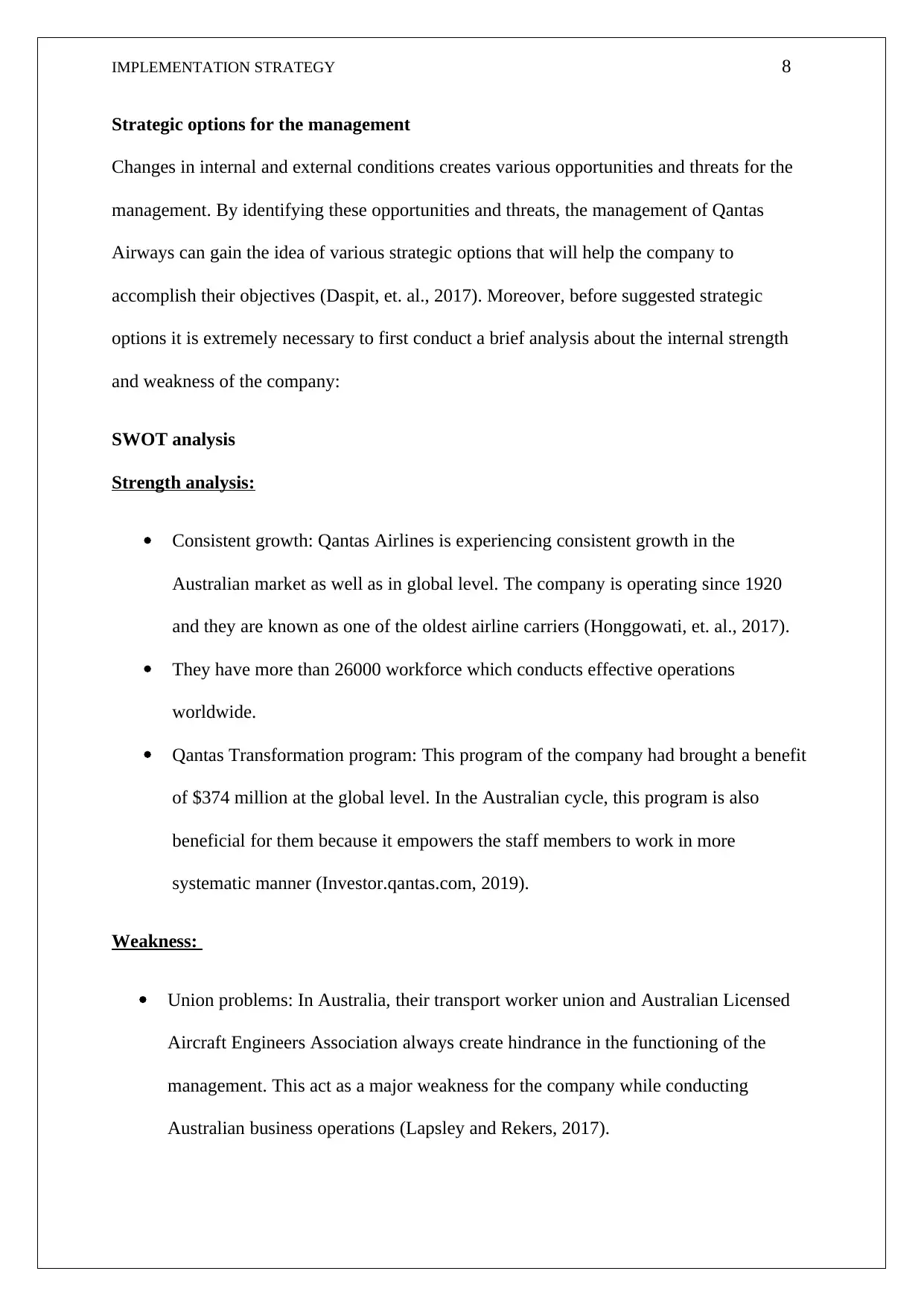
IMPLEMENTATION STRATEGY 8
Strategic options for the management
Changes in internal and external conditions creates various opportunities and threats for the
management. By identifying these opportunities and threats, the management of Qantas
Airways can gain the idea of various strategic options that will help the company to
accomplish their objectives (Daspit, et. al., 2017). Moreover, before suggested strategic
options it is extremely necessary to first conduct a brief analysis about the internal strength
and weakness of the company:
SWOT analysis
Strength analysis:
Consistent growth: Qantas Airlines is experiencing consistent growth in the
Australian market as well as in global level. The company is operating since 1920
and they are known as one of the oldest airline carriers (Honggowati, et. al., 2017).
They have more than 26000 workforce which conducts effective operations
worldwide.
Qantas Transformation program: This program of the company had brought a benefit
of $374 million at the global level. In the Australian cycle, this program is also
beneficial for them because it empowers the staff members to work in more
systematic manner (Investor.qantas.com, 2019).
Weakness:
Union problems: In Australia, their transport worker union and Australian Licensed
Aircraft Engineers Association always create hindrance in the functioning of the
management. This act as a major weakness for the company while conducting
Australian business operations (Lapsley and Rekers, 2017).
Strategic options for the management
Changes in internal and external conditions creates various opportunities and threats for the
management. By identifying these opportunities and threats, the management of Qantas
Airways can gain the idea of various strategic options that will help the company to
accomplish their objectives (Daspit, et. al., 2017). Moreover, before suggested strategic
options it is extremely necessary to first conduct a brief analysis about the internal strength
and weakness of the company:
SWOT analysis
Strength analysis:
Consistent growth: Qantas Airlines is experiencing consistent growth in the
Australian market as well as in global level. The company is operating since 1920
and they are known as one of the oldest airline carriers (Honggowati, et. al., 2017).
They have more than 26000 workforce which conducts effective operations
worldwide.
Qantas Transformation program: This program of the company had brought a benefit
of $374 million at the global level. In the Australian cycle, this program is also
beneficial for them because it empowers the staff members to work in more
systematic manner (Investor.qantas.com, 2019).
Weakness:
Union problems: In Australia, their transport worker union and Australian Licensed
Aircraft Engineers Association always create hindrance in the functioning of the
management. This act as a major weakness for the company while conducting
Australian business operations (Lapsley and Rekers, 2017).
⊘ This is a preview!⊘
Do you want full access?
Subscribe today to unlock all pages.

Trusted by 1+ million students worldwide
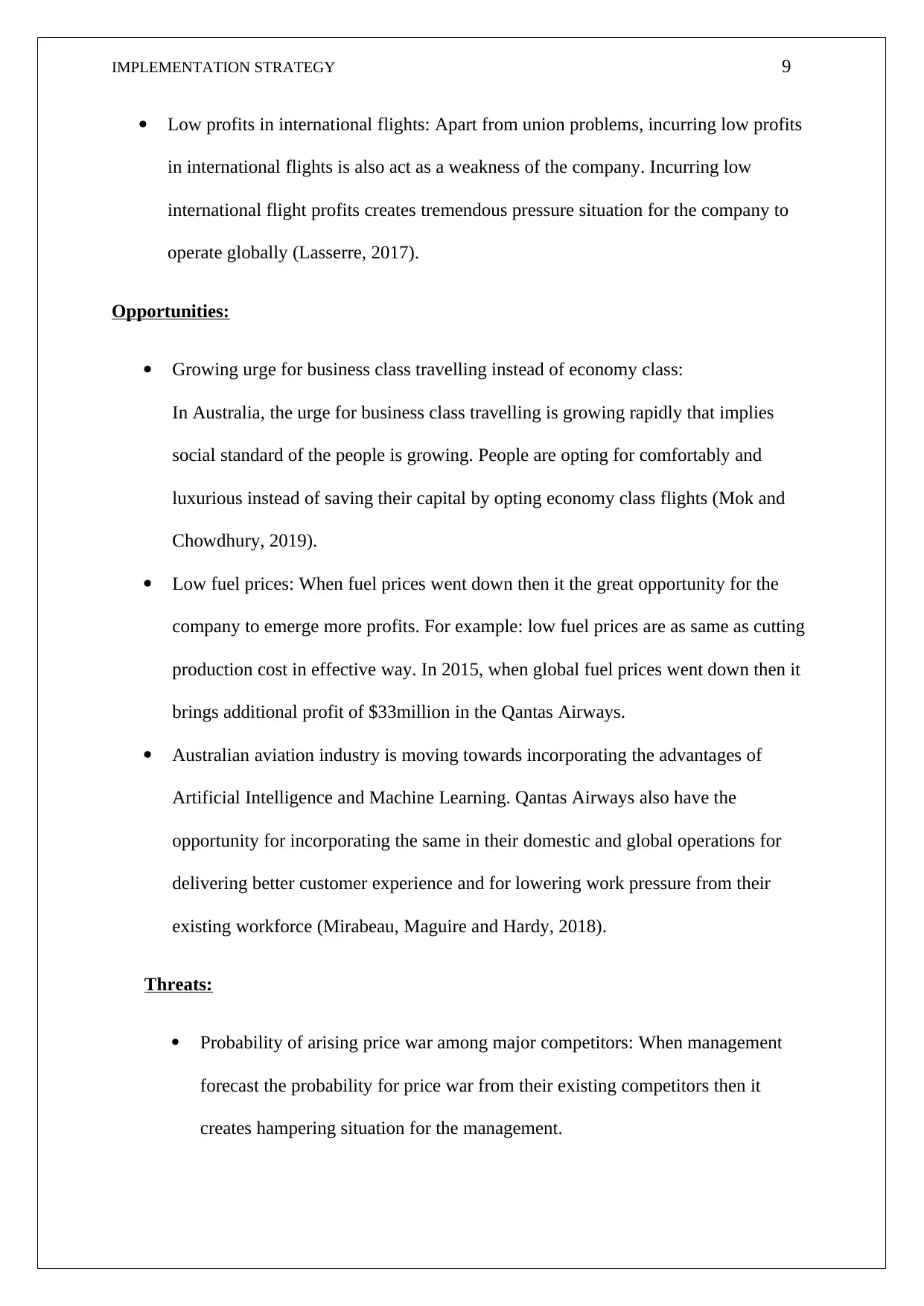
IMPLEMENTATION STRATEGY 9
Low profits in international flights: Apart from union problems, incurring low profits
in international flights is also act as a weakness of the company. Incurring low
international flight profits creates tremendous pressure situation for the company to
operate globally (Lasserre, 2017).
Opportunities:
Growing urge for business class travelling instead of economy class:
In Australia, the urge for business class travelling is growing rapidly that implies
social standard of the people is growing. People are opting for comfortably and
luxurious instead of saving their capital by opting economy class flights (Mok and
Chowdhury, 2019).
Low fuel prices: When fuel prices went down then it the great opportunity for the
company to emerge more profits. For example: low fuel prices are as same as cutting
production cost in effective way. In 2015, when global fuel prices went down then it
brings additional profit of $33million in the Qantas Airways.
Australian aviation industry is moving towards incorporating the advantages of
Artificial Intelligence and Machine Learning. Qantas Airways also have the
opportunity for incorporating the same in their domestic and global operations for
delivering better customer experience and for lowering work pressure from their
existing workforce (Mirabeau, Maguire and Hardy, 2018).
Threats:
Probability of arising price war among major competitors: When management
forecast the probability for price war from their existing competitors then it
creates hampering situation for the management.
Low profits in international flights: Apart from union problems, incurring low profits
in international flights is also act as a weakness of the company. Incurring low
international flight profits creates tremendous pressure situation for the company to
operate globally (Lasserre, 2017).
Opportunities:
Growing urge for business class travelling instead of economy class:
In Australia, the urge for business class travelling is growing rapidly that implies
social standard of the people is growing. People are opting for comfortably and
luxurious instead of saving their capital by opting economy class flights (Mok and
Chowdhury, 2019).
Low fuel prices: When fuel prices went down then it the great opportunity for the
company to emerge more profits. For example: low fuel prices are as same as cutting
production cost in effective way. In 2015, when global fuel prices went down then it
brings additional profit of $33million in the Qantas Airways.
Australian aviation industry is moving towards incorporating the advantages of
Artificial Intelligence and Machine Learning. Qantas Airways also have the
opportunity for incorporating the same in their domestic and global operations for
delivering better customer experience and for lowering work pressure from their
existing workforce (Mirabeau, Maguire and Hardy, 2018).
Threats:
Probability of arising price war among major competitors: When management
forecast the probability for price war from their existing competitors then it
creates hampering situation for the management.
Paraphrase This Document
Need a fresh take? Get an instant paraphrase of this document with our AI Paraphraser
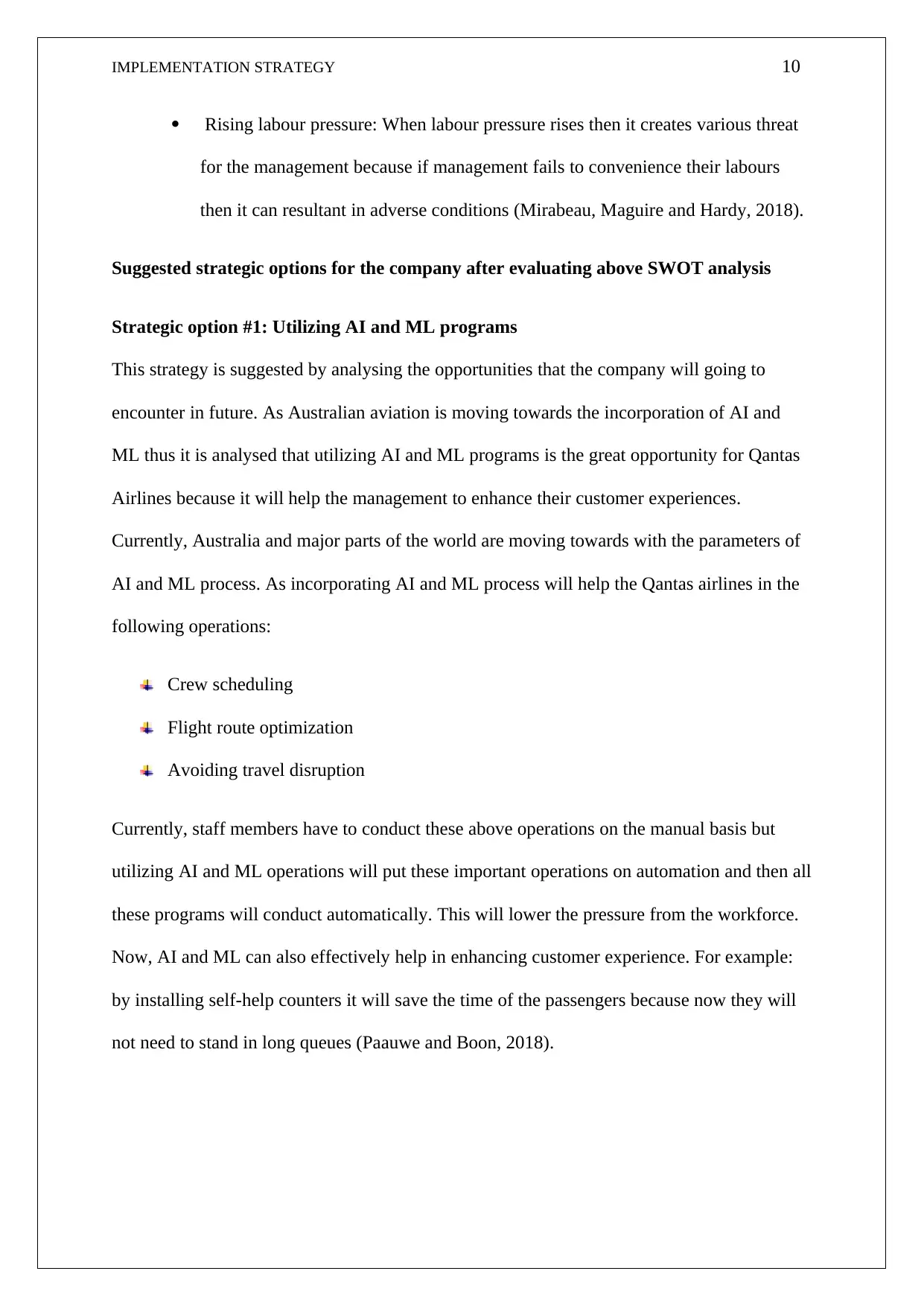
IMPLEMENTATION STRATEGY 10
Rising labour pressure: When labour pressure rises then it creates various threat
for the management because if management fails to convenience their labours
then it can resultant in adverse conditions (Mirabeau, Maguire and Hardy, 2018).
Suggested strategic options for the company after evaluating above SWOT analysis
Strategic option #1: Utilizing AI and ML programs
This strategy is suggested by analysing the opportunities that the company will going to
encounter in future. As Australian aviation is moving towards the incorporation of AI and
ML thus it is analysed that utilizing AI and ML programs is the great opportunity for Qantas
Airlines because it will help the management to enhance their customer experiences.
Currently, Australia and major parts of the world are moving towards with the parameters of
AI and ML process. As incorporating AI and ML process will help the Qantas airlines in the
following operations:
Crew scheduling
Flight route optimization
Avoiding travel disruption
Currently, staff members have to conduct these above operations on the manual basis but
utilizing AI and ML operations will put these important operations on automation and then all
these programs will conduct automatically. This will lower the pressure from the workforce.
Now, AI and ML can also effectively help in enhancing customer experience. For example:
by installing self-help counters it will save the time of the passengers because now they will
not need to stand in long queues (Paauwe and Boon, 2018).
Rising labour pressure: When labour pressure rises then it creates various threat
for the management because if management fails to convenience their labours
then it can resultant in adverse conditions (Mirabeau, Maguire and Hardy, 2018).
Suggested strategic options for the company after evaluating above SWOT analysis
Strategic option #1: Utilizing AI and ML programs
This strategy is suggested by analysing the opportunities that the company will going to
encounter in future. As Australian aviation is moving towards the incorporation of AI and
ML thus it is analysed that utilizing AI and ML programs is the great opportunity for Qantas
Airlines because it will help the management to enhance their customer experiences.
Currently, Australia and major parts of the world are moving towards with the parameters of
AI and ML process. As incorporating AI and ML process will help the Qantas airlines in the
following operations:
Crew scheduling
Flight route optimization
Avoiding travel disruption
Currently, staff members have to conduct these above operations on the manual basis but
utilizing AI and ML operations will put these important operations on automation and then all
these programs will conduct automatically. This will lower the pressure from the workforce.
Now, AI and ML can also effectively help in enhancing customer experience. For example:
by installing self-help counters it will save the time of the passengers because now they will
not need to stand in long queues (Paauwe and Boon, 2018).
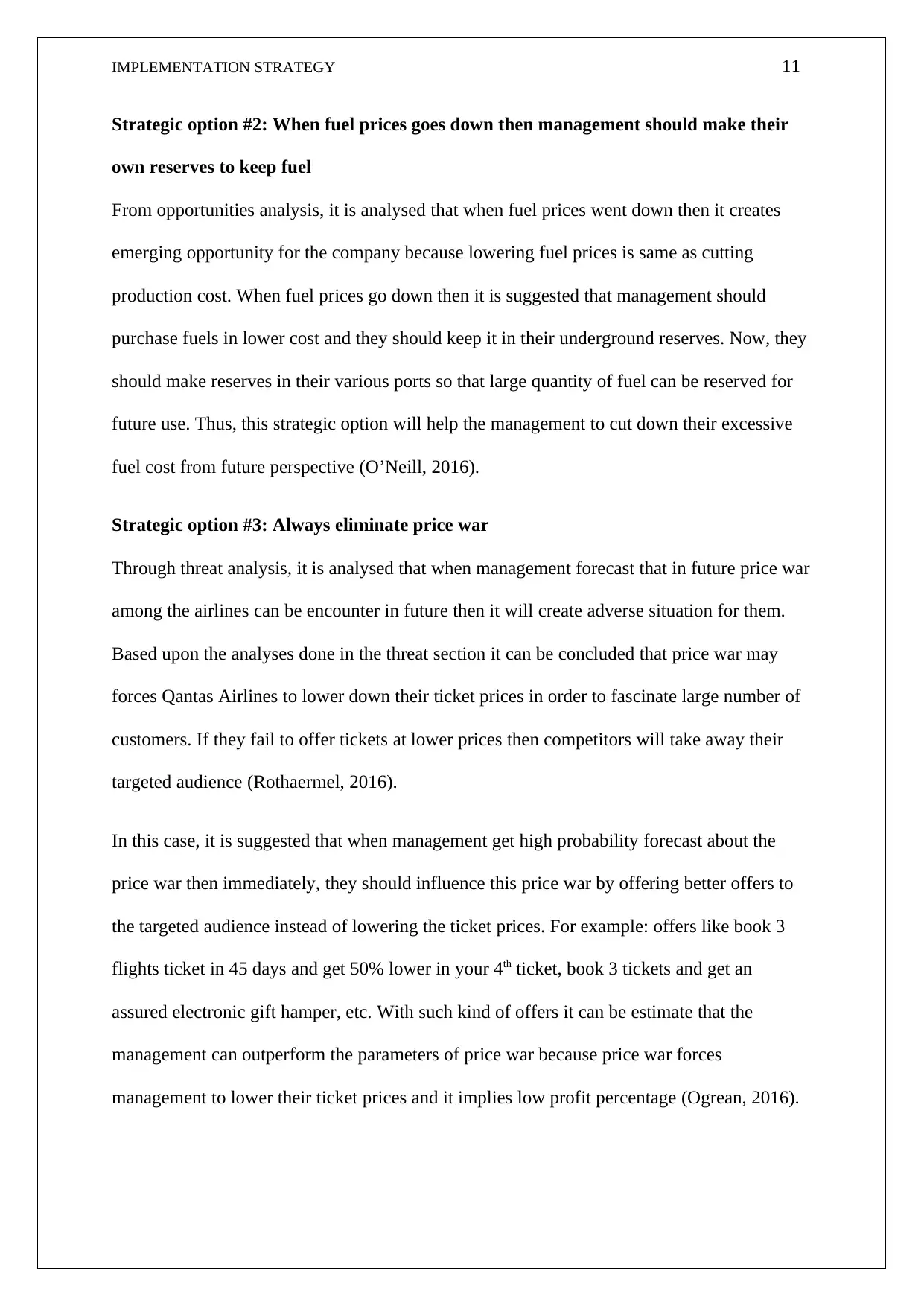
IMPLEMENTATION STRATEGY 11
Strategic option #2: When fuel prices goes down then management should make their
own reserves to keep fuel
From opportunities analysis, it is analysed that when fuel prices went down then it creates
emerging opportunity for the company because lowering fuel prices is same as cutting
production cost. When fuel prices go down then it is suggested that management should
purchase fuels in lower cost and they should keep it in their underground reserves. Now, they
should make reserves in their various ports so that large quantity of fuel can be reserved for
future use. Thus, this strategic option will help the management to cut down their excessive
fuel cost from future perspective (O’Neill, 2016).
Strategic option #3: Always eliminate price war
Through threat analysis, it is analysed that when management forecast that in future price war
among the airlines can be encounter in future then it will create adverse situation for them.
Based upon the analyses done in the threat section it can be concluded that price war may
forces Qantas Airlines to lower down their ticket prices in order to fascinate large number of
customers. If they fail to offer tickets at lower prices then competitors will take away their
targeted audience (Rothaermel, 2016).
In this case, it is suggested that when management get high probability forecast about the
price war then immediately, they should influence this price war by offering better offers to
the targeted audience instead of lowering the ticket prices. For example: offers like book 3
flights ticket in 45 days and get 50% lower in your 4th ticket, book 3 tickets and get an
assured electronic gift hamper, etc. With such kind of offers it can be estimate that the
management can outperform the parameters of price war because price war forces
management to lower their ticket prices and it implies low profit percentage (Ogrean, 2016).
Strategic option #2: When fuel prices goes down then management should make their
own reserves to keep fuel
From opportunities analysis, it is analysed that when fuel prices went down then it creates
emerging opportunity for the company because lowering fuel prices is same as cutting
production cost. When fuel prices go down then it is suggested that management should
purchase fuels in lower cost and they should keep it in their underground reserves. Now, they
should make reserves in their various ports so that large quantity of fuel can be reserved for
future use. Thus, this strategic option will help the management to cut down their excessive
fuel cost from future perspective (O’Neill, 2016).
Strategic option #3: Always eliminate price war
Through threat analysis, it is analysed that when management forecast that in future price war
among the airlines can be encounter in future then it will create adverse situation for them.
Based upon the analyses done in the threat section it can be concluded that price war may
forces Qantas Airlines to lower down their ticket prices in order to fascinate large number of
customers. If they fail to offer tickets at lower prices then competitors will take away their
targeted audience (Rothaermel, 2016).
In this case, it is suggested that when management get high probability forecast about the
price war then immediately, they should influence this price war by offering better offers to
the targeted audience instead of lowering the ticket prices. For example: offers like book 3
flights ticket in 45 days and get 50% lower in your 4th ticket, book 3 tickets and get an
assured electronic gift hamper, etc. With such kind of offers it can be estimate that the
management can outperform the parameters of price war because price war forces
management to lower their ticket prices and it implies low profit percentage (Ogrean, 2016).
⊘ This is a preview!⊘
Do you want full access?
Subscribe today to unlock all pages.

Trusted by 1+ million students worldwide
1 out of 21
Related Documents
Your All-in-One AI-Powered Toolkit for Academic Success.
+13062052269
info@desklib.com
Available 24*7 on WhatsApp / Email
![[object Object]](/_next/static/media/star-bottom.7253800d.svg)
Unlock your academic potential
Copyright © 2020–2025 A2Z Services. All Rights Reserved. Developed and managed by ZUCOL.




